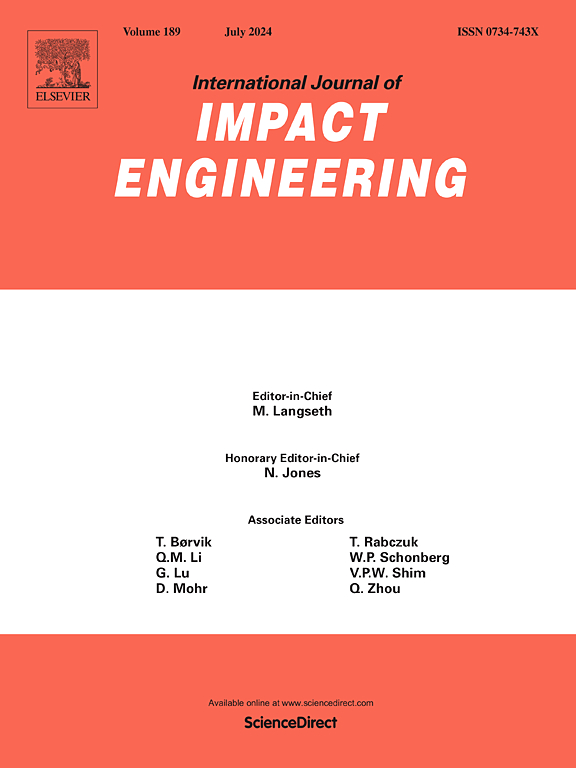High strain rate testing of carbon-epoxy laminate crash boxes filled with polymeric cellular 3D-printed cores
IF 5.1
2区 工程技术
Q1 ENGINEERING, MECHANICAL
International Journal of Impact Engineering
Pub Date : 2025-05-24
DOI:10.1016/j.ijimpeng.2025.105401
引用次数: 0
Abstract
In recent years, rising attention has been given to lightweight crash-absorbing composite components. The cost of their realization could be mitigated by the hybridization with 3D-printed cellular infills, limiting the use of high-value materials such as CFRP. The energy absorption capabilities of 3D-printed cellular structures have been proven to be relevant for crash-absorbing applications. In this study, both quasi-static and high strain rate tests are conducted on hybrid crash boxes fabricated by joining an internal 3D-printed infill with an external CFRP reinforcement. A finite element model is developed to reproduce and predict the high strain rate behavior of the structures. Two different internal cellular structures are used as a mold for the hand-layup process of twill carbon-epoxy prepreg, which is applied directly on the 3D-printed surface. Quasi-static tests show that the addition of CFRP to the 3D-printed infill is beneficial for the improvement of the specific energy absorption, with values up to 15 J/g for the maximum reinforced crash box. High strain rate tests show notable differences, highlighting distinct failure and collapse modes, which strongly affect the mechanical properties of the reinforced crash boxes. While unreinforced crash boxes show an improvement of up to 20 % in Specific Energy Absorption (SEA), drops of up to 30 % and 40 % are observed in reinforced crash boxes for Crush Force Efficiency (CFE) and SEA respectively. This suggests that a more appropriate design should be followed to contrast the unfavorable failure and collapse modes observed in impact scenarios.

用聚合物蜂窝3d打印芯填充的碳-环氧层压板碰撞盒的高应变率测试
近年来,轻量化减震复合材料部件受到越来越多的关注。它们的实现成本可以通过与3d打印细胞填充材料的杂交来降低,从而限制了高价值材料(如CFRP)的使用。3d打印细胞结构的能量吸收能力已被证明与碰撞吸收应用相关。在这项研究中,通过将内部3d打印填充材料与外部CFRP增强材料连接而制成的混合碰撞箱进行了准静态和高应变率测试。建立了一个有限元模型来再现和预测结构的高应变率行为。两种不同的内部细胞结构被用作斜纹碳-环氧预浸料手工铺层工艺的模具,直接应用于3d打印表面。准静态试验表明,在3d打印填充材料中加入CFRP有利于提高比能吸收,增强碰撞箱的最大比能吸收可达15 J/g。高应变率试验显示出显著的差异,突出了不同的破坏和破坏模式,这强烈影响了增强碰撞箱的力学性能。虽然未加固的碰撞箱在比能量吸收(SEA)方面提高了20%,但在粉碎力效率(CFE)和SEA方面,加固的碰撞箱分别下降了30%和40%。这表明应该采用更合适的设计来对比在冲击情景中观察到的不利破坏和崩溃模式。
本文章由计算机程序翻译,如有差异,请以英文原文为准。
求助全文
约1分钟内获得全文
求助全文
来源期刊

International Journal of Impact Engineering
工程技术-工程:机械
CiteScore
8.70
自引率
13.70%
发文量
241
审稿时长
52 days
期刊介绍:
The International Journal of Impact Engineering, established in 1983 publishes original research findings related to the response of structures, components and materials subjected to impact, blast and high-rate loading. Areas relevant to the journal encompass the following general topics and those associated with them:
-Behaviour and failure of structures and materials under impact and blast loading
-Systems for protection and absorption of impact and blast loading
-Terminal ballistics
-Dynamic behaviour and failure of materials including plasticity and fracture
-Stress waves
-Structural crashworthiness
-High-rate mechanical and forming processes
-Impact, blast and high-rate loading/measurement techniques and their applications
 求助内容:
求助内容: 应助结果提醒方式:
应助结果提醒方式:


